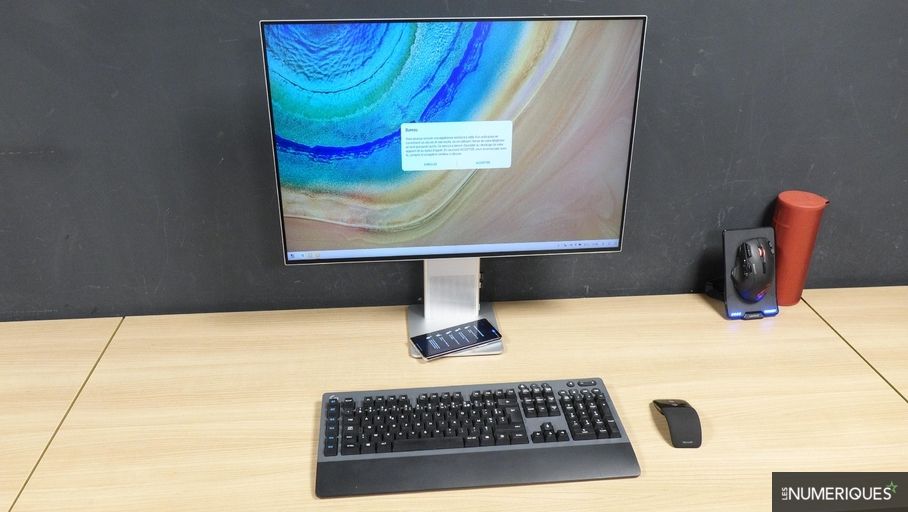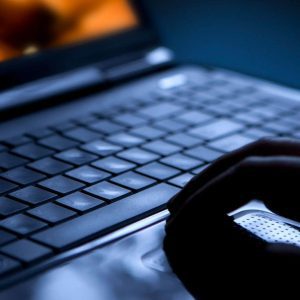4
In addition to the UltraHD + panel with a 3: 2 ratio, the Huawei MateView 28 is distinguished by its wireless connection to smartphones and PCs running Windows 10, but in practice this system is not very convincing.
Available on August 8, Huawei MateView 28 is the new high-end display from the Chinese manufacturer. It stands out from the competition with its well-polished aluminum frame, ultra-thin screen bezels and Ultra HD+ 3840 x 2560 pixel definition in a very original 3:2 ratio. Another originality of the screen comes from the connection. In addition to the classic HDMI, Mini DisplayPort and USB-C, the MateView 28 includes Bluetooth, wifi, and an NFC chip for wireless connectivity to Huawei smartphones and Windows 10 PCs.
Wireless connection to a Huawei smartphone
The Huawei Mate 40 Pro easily connects to the screen with a simple touch of the base.
Wireless smartphone connectivity only works with Huawei models with NFC chip and EMUI 10.0 (or higher). This is done very simply by touching the Huawei Share sensor area which is embodied by an icon on the base of the foot. The smartphone then asks to validate the connection and then a window appears on the screen to confirm the connection as well, either for this time only or permanently.
Wireless projection viewed from a smartphone. (Adran is arrested)
By default, the screen mirrors the screen of the smartphone, which is useful for viewing information or, for example, watching a video. Huawei also offers a desktop mode similar to Samsung’s DeX. Then the screen displays a different interface with the taskbar and applications. When the browser opens, a window opens on the screen, just like on a computer. The smartphone then switches to the touchpad and when you have to enter text, the virtual keyboard appears. Unfortunately, devices connected via USB to the monitor are not supported. To use an external keyboard and mouse, they must be connected to the smartphone via Bluetooth directly. The process is surprisingly smooth – in all cases with the Mate 40 Pro – and the various tasks are performed without difficulty.
USB-C connection to a Huawei smartphone
Connection is also possible with a USB-C cable.
As with many USB-C displays, it is also possible to connect a smartphone directly to the display using the USB-C cable included with the MateView. We find the same process as with Wireless Display mode except that USB devices are supported here. In our case, the keyboard and mouse with the dongle connected work perfectly.
Definition stuck at 16:9 ratio. (screenshot)
On the other hand, for some inexplicable reason, the screen is satisfied with a 16:9 image when connected via USB-C to the phone, while the latter makes good use of the entire surface of the phone. View the phone when connected via wireless projection.
Wireless connection to a computer is very fickle
Wireless connection to a computer is easy.
Connecting to Windows 10 computers compatible with Miracast is very easy. Just activate a file screen display On the screen, the latter can be detected via Bluetooth and then on the PC you have to open the display settings (right click on the desktop) and choose the option “Connect to a wireless display”. The MateView 28 screen will appear in the window on the right. So the screen behaves like a standard screen. It is possible to copy the main screen or extend the view. So much for the contact part. In practice, things get a little tricky.
Artifacts are shown in the image. The screen shows the same image here as in the first image, but it appears to have a connection problem.
The laptop creates a direct link to the screen and local wifi performance is not expected to affect display quality. However, even if it is placed a few centimeters away, the wireless display on the Huawei screen is almost unusable in our case. Mouse latency is very important and above all the image is refreshed randomly with some artifacts sometimes like in the above image. As it stands, this walkie-talkie isn’t fun to use, at least in our setup.
With a USB-C compatible computer, the most practical way is to connect the computer with a USB-C cable. The latter allows you to recharge the laptop, use the two USB 3.0 ports on the edge to connect a keyboard and mouse, for example, and send a video signal to the monitor. In short, one cable is enough to turn the monitor into a kind of docking station, with a guarantee of charging and without any display problem.
See you on Monday, August 9 for the full test of the Huawei MateView 28 screen.

“Certified gamer. Problem solver. Internet enthusiast. Twitter scholar. Infuriatingly humble alcohol geek. Tv guru.”





